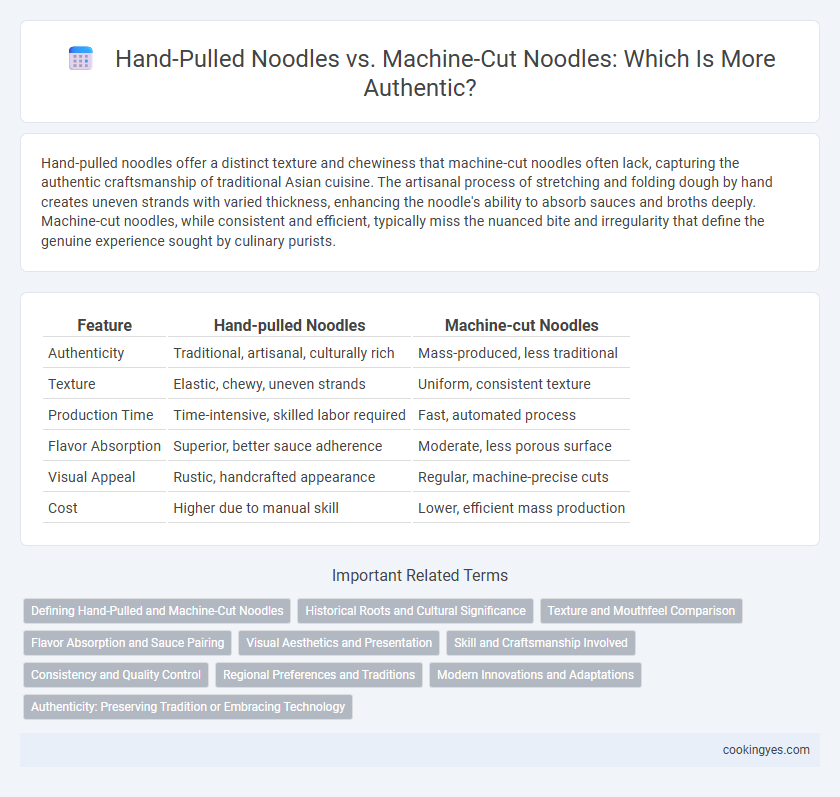Hand-pulled noodles offer a distinct texture and chewiness that machine-cut noodles often lack, capturing the authentic craftsmanship of traditional Asian cuisine. The artisanal process of stretching and folding dough by hand creates uneven strands with varied thickness, enhancing the noodle's ability to absorb sauces and broths deeply. Machine-cut noodles, while consistent and efficient, typically miss the nuanced bite and irregularity that define the genuine experience sought by culinary purists.
Table of Comparison
| Feature | Hand-pulled Noodles | Machine-cut Noodles |
|---|---|---|
| Authenticity | Traditional, artisanal, culturally rich | Mass-produced, less traditional |
| Texture | Elastic, chewy, uneven strands | Uniform, consistent texture |
| Production Time | Time-intensive, skilled labor required | Fast, automated process |
| Flavor Absorption | Superior, better sauce adherence | Moderate, less porous surface |
| Visual Appeal | Rustic, handcrafted appearance | Regular, machine-precise cuts |
| Cost | Higher due to manual skill | Lower, efficient mass production |
Defining Hand-Pulled and Machine-Cut Noodles
Hand-pulled noodles are crafted by skillfully stretching and folding dough multiple times to create ultra-thin, elastic strands, embodying traditional Chinese culinary artistry. Machine-cut noodles, produced by slicing rolled dough with industrial cutters, offer consistency and efficiency but often lack the unique texture and chewiness found in hand-pulled varieties. Authenticity in noodle preparation is closely tied to the hand-pulling technique, which preserves the dough's natural gluten development and imparts a distinctive mouthfeel unattainable through machine cutting.
Historical Roots and Cultural Significance
Hand-pulled noodles, originating from ancient Chinese culinary traditions, showcase a mastery of dough elasticity and technique that embodies authentic craftsmanship, reflecting centuries of cultural heritage. Machine-cut noodles, while efficient for mass production, lack the nuanced texture and irregularity that hand-pulled methods impart, making them less representative of traditional eating experiences. The historical roots of hand-pulled noodles highlight their significance in regional celebrations and daily diets, preserving an artisanal legacy that machine-cut variants cannot replicate.
Texture and Mouthfeel Comparison
Hand-pulled noodles boast a distinct chewy texture and irregular thickness that enhance mouthfeel, mimicking traditional culinary techniques prized in authentic Asian cuisine. Machine-cut noodles offer uniform thickness and consistent cooking but often lack the elasticity and complex bite found in hand-pulled varieties. Textural differences significantly impact sensory experience, with hand-pulled noodles delivering a more dynamic and satisfying chew.
Flavor Absorption and Sauce Pairing
Hand-pulled noodles offer superior texture and enhanced flavor absorption due to their uneven surfaces, which trap sauces more effectively than machine-cut noodles. The irregular thickness of hand-pulled noodles allows for better interaction with rich, slow-cooked sauces such as braised beef or spicy chili oil, intensifying the overall taste experience. Machine-cut noodles, while uniform and efficient, often lack the porous quality needed to fully capture and complement complex sauce profiles.
Visual Aesthetics and Presentation
Hand-pulled noodles exhibit irregular thickness and slightly uneven edges, creating a visually authentic and artisanal appearance that appeals to traditional culinary aesthetics. Machine-cut noodles offer uniformity in size and shape, ensuring consistent presentation but often lacking the rustic charm valued in authentic dishes. Visual aesthetics in hand-pulled noodles enhance the sensory experience by showcasing craftsmanship, making them preferable in authentic Asian cuisine presentations.
Skill and Craftsmanship Involved
Hand-pulled noodles showcase exceptional skill and craftsmanship, requiring years of practice to perfect the dough stretching and folding technique that produces the characteristic chewy texture and irregular thickness. Machine-cut noodles, while efficient and consistent in shape, often lack the nuanced texture and artisanal qualities achieved through manual pulling. Authenticity in noodle preparation is deeply tied to the traditional hand-pulling process, where the tactile control and expertise directly influence the final taste and mouthfeel.
Consistency and Quality Control
Hand-pulled noodles offer unparalleled authenticity with their unique texture and traditional craftsmanship, but they often face challenges in consistency due to manual variations. Machine-cut noodles provide precise uniformity and enhanced quality control, ensuring each batch meets strict standards for texture and thickness. Balancing traditional hand-pulling methods with modern machine precision optimizes both the authentic experience and reliable product quality.
Regional Preferences and Traditions
Hand-pulled noodles, renowned for their elasticity and chewy texture, are deeply rooted in Chinese regional traditions such as Shanxi and Lanzhou, where artisanal techniques emphasize craftsmanship and authenticity. Machine-cut noodles offer consistency and efficiency, widely favored in urban areas and commercial kitchens, but they often lack the nuanced texture prized in traditional dishes. Regional preferences strongly influence choice, with rural and specialty eateries maintaining hand-pulled methods to preserve cultural heritage and flavor authenticity.
Modern Innovations and Adaptations
Hand-pulled noodles preserve traditional craftsmanship, offering authentic texture and elasticity unmatched by machine-cut noodles. Modern innovations include automated hand-pulling machines that replicate the artisanal stretch-and-pull process, blending authenticity with efficiency. Adaptations such as precision dough control and advanced drying techniques enhance consistency while maintaining the handmade noodle's unique bite and chew.
Authenticity: Preserving Tradition or Embracing Technology
Hand-pulled noodles embody centuries-old craftsmanship, offering a texture and elasticity that highlight authentic regional flavors often lost in mass production. Machine-cut noodles provide consistency, speed, and scalability, catering to modern demands without fully replicating the nuanced bite and chew of hand-pulled varieties. The choice between preserving tradition through hand-pulling or embracing technology depends on balancing authenticity with efficiency in culinary practices.
Hand-pulled noodles vs Machine-cut noodles for authenticity Infographic

 cookingyes.com
cookingyes.com